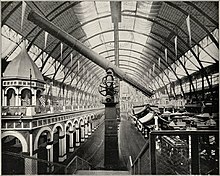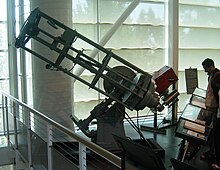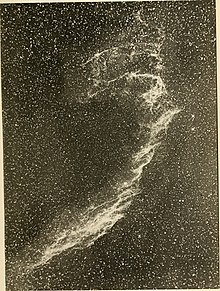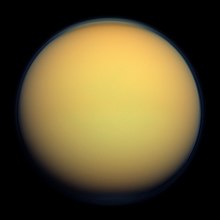Yerkes Observatory
Ownership was transferred to the non-profit Yerkes Future Foundation (YFF) in May 2020, which began millions of dollars of restoration and renovation of the historic building and grounds.
The observatory, often called "the birthplace of modern astrophysics", was founded in 1892 by astronomer George Ellery Hale and financed by businessman Charles T. Yerkes.
The observatory's main dome houses a 40 in-diameter (102 cm) doublet lens refracting telescope, the second-largest refractor ever successfully used for astronomy.
Prior to its installation, the telescope on its enormous German equatorial mount was shown at the World's Columbian Exhibition in Chicago, Illinois during the time the observatory was under construction.
[6] The community-based foundation hired a director and launched a $25M campaign to restore the observatory and the fifty acres of historic Olmsted-designed grounds.
The mission of Yerkes is to "...advance humankind's understanding of the universe and our place within it, igniting curiosity, facilitating exploration, and nurturing a deep sense of connection with our environment, our planet and each other.
In 2023, Yerkes opened four newly-built miles of walking trails and installed the first commissioned outdoor sculpture by artist Ashley Zelinskie.
Yerkes has hosted talks, programs or residencies with Grammy-winning musicians and composers Eighth Blackbird, Brooklyn-based artist Ashley Zelinskie, former US Poet Laureate Tracy K Smith, astronomer and public educator Dean Regas, and former Senior Scientist of the James Webb Space Telescope and Nobel prizewinner Dr. John Mather.
The telescope was surpassed by the Harvard College Observatory, 60 in (152 cm) reflector less than ten years later, although it remained a center for research for decades afterwards.
Yerkes Observatory's 40-inch (102 cm) refracting telescope has a doublet lens produced by the optical firm Alvan Clark & Sons and a mounting by the Warner & Swasey Company.
[11]The glass blanks for what would become Yerkes Great Refractor were made in Paris, France by Mantois and delivered to Alvan Clark & Sons in Massachusetts where they were completed.
For example, the Leviathan of Parsonstown was a 1.8 meter telescope with a speculum metal mirror, but getting good astronomical results from this technology could be difficult.
[28] This was a design by Boller & Chivens with Cassegrain optical setup, with a 24-inch (61 cm) clear aperture and is on an off-axis equatorial mount.
includes work on the interstellar medium, globular cluster formation, infrared astronomy, and near-Earth objects.
In 2012 the engineers completed work on the High-resolution Airborne Wideband Camera (HAWC), part of the Stratospheric Observatory for Infrared Astronomy (SOFIA).
In June 1967, Yerkes Observatory hosted the to-date largest meeting of the American Astronomical Society, with talks on over 200 papers.
Some additional examples include 990 Yerkes, 991 McDonalda, and 992 Swasey around this time; many more minor planets would be discovered at the observatory in the following decades.
Notable astronomers who conducted research at Yerkes include Albert Michelson,[45] Edwin Hubble (who did his graduate work at Yerkes and for whom the Hubble Space Telescope was named), Subrahmanyan Chandrasekhar (for whom the Chandra Space Telescope was named), Ukrainian-American astronomer Otto Struve,[3] Dutch-American astronomer Gerard Kuiper (noted for theorizing the Kuiper belt, home to dwarf planet Pluto), Nancy Grace Roman, NASA's first Chief of Astronomy (who did her graduate work at Yerkes), and the twentieth-century popularizer of astronomy Carl Sagan.
She came to Yerkes from the Vera Rubin Telescope, then under construction in Chile, and was appointed the first-ever Montgomery Foundation Deputy Director and Head of Science and Education.
Under the plan, a 100-room resort with a large spa operation and attendant parking and support facilities was to be located on the 9-acre (36,000 m2) virgin wooded Yerkes land on the lakeshore—the last such undeveloped, natural site on Geneva Lake's 21 mi (34 km) shoreline.
[48] In May 2018, the Yerkes Future Foundation, a group of local residents, submitted an expression of interest to the University of Chicago with a proposal that would seek to maintain public access to the site and continuation of the educational programs.
Some research activities continued at the Observatory, including access and use of the extensive historical glass plate archives at the site.
Yerkes education and outreach staff formed a nonprofit organization – GLAS – to continue their programs at another site after the closing.
[58] Although it does not have a high-altitude as preferred by modern observatories, it does have good weather, and is a considerable distance from the light and pollution of Chicago.
[61] The original landscape plan was not completed by the 1897 dedication, and there was grading and construction of gravel roads under direction of the Olmsted design as late as 1908.
The Yerkes was perhaps the greatest of the great refractors, the largest astronomical instrument in the traditional style of the 19th century refractor-based observatories.
[65] *Note the Leviathan of Parsonstown was not used after 1890 Understanding atmosphere and trends of telescope building of the late 19th century puts the choice of a large refractor in perspective.
Silvering has its own issues, in that coating must be reapplied usually every 2 years or so depending on conditions, and also it must be done very thinly so as to not affect the optical properties of the mirror.
Small refractors remain popular for astronomical photography, although issues with chromatic aberration were never really entirely solved for the lens.
The importance of finely crafted mounts matched to a large aperture, harnessing the power of the basic equations of the telescopes design to bring the heavens into closer, brighter examination increased humankind's understanding of space and Earth's place in the Galaxy.





















